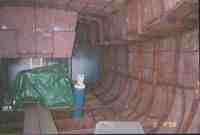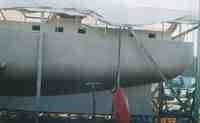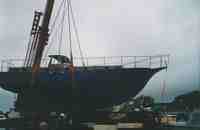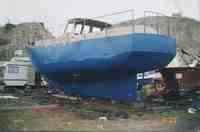
Inside bulkheads, floor joists, tanks and
external fittings
Before
I could move opperations to the inside of the hull there were a few things that
I had not finished or even thought about.
Firstly railings so steel tube was purchased and fabricated into stanchions and
railings. Lazarette lockers and chain locker were finished, bulwark capping was
bent into shape which took ages as it was 50mm by 5mm flat bar which was hard
to work. The next question was were we going to have a doghouse or not? A week
of debate followed. Bruce Roberts steel boat building books were read again and
the conclusion was that we definitely needed a doghouse. I contacted Bruce
again and he said he had stock designs and all we had to do was choose one.
What he did not say was that he wanted £750 for the drawings. I laughed a lot
and decided to design my own. It took until March 2000 to complete the doghouse
and all those little jobs that did not sound important enough to finish.
At long last I could move to the inside of the boat. Here bulkheads were welded
in place for the engine room, forward shower and heads, aft cabin, galley and
navigation station. Next was the question of tanks. I had thought a lot about
these and although it would have been cheaper to make them an integral part of
the hull I had heard lots of stories about fuel being contaminated by steel
tanks, water tasting bad and a lot more. So I decided to invest in plastic
tanks. I had been to see TekTanks at the boat show and was very impressed with
their all plastic hand built tanks for both diesel and water. In addition to
these I also wanted a grey water and a black water holding tank as I had read a
lot about these being required in the eastern Mediterranean.
TekTanks were very helpful and did all the design all I had to do was give them
the measurements and they did the rest. They advised on how to fix the tanks to
the boat, how to run the fillers, vents and diesel and water take offs. I was
very pleased with the design and their expertise. The order was placed and
delivery was to be later in the year when I had had the boat shot blasted and
primed.
So began the task of building the tank mounts and welding into place the beams
which would eventually carry the floor. After this stand pipes of the correct
diameter and wall thickness were welded onto the through hull holes previously
cut to take the seacocks for engine water intake, heads intake, and both grey
and black water holding tank pump out. The plan was to have all the grey water
drain into the grey water holding tank first and also the heads pump directly
into the black water holding tank. These could then be pumped out at a
convenient time allowing only one seacock to be needed instead of many. I do
not like holes in my hull.
All the inside steel work was completed by the end of August 2000. Now it was
time to shot blast and prime the boat. I searched round for a company that
could shot blast both the inside and outside of the hull and then to airless
spray the first 2 coats of primer on all the surfaces. Bristol Shotblasting
Services got the job. They could start mid September allowing me just enough
time to double check all the steel bits were completed and that I had not
forgotten anything. It also allowed me to go to the Southampton Boat Show to
get a deal on a paint system. I went to all the manufacturers and they all were
saying the same thing. However, Blakes paints sounded good and were offering a
great deal. So they were chosen. I bought the complete system including their
EPU primer which is epoxy based and their topcoat and deck paint. The whole lot
was about £2000.

Shot blasting and first primer coat
Mid
September came and the shot blasting started. Bristol Shotblasting did a great
job. In fact I did not realise what a great job they did until the summer of
2005, but more about that when I talk about our refit.
Meanwhile Ann’s Mum was getting very frail. She had moved down from west Wales in 1994
as her husband died in 1992 and she was very lonely on her own. She sold her
house and we bought a larger home with accommodation for her in the form of a
granny annex. She was always telling us that she wanted to go back to West Wales so as the boat was taking shape and we could
see our self living on her the next year we decided to move to Milford Haven.
This would get Ann’s Mum back to Wales and also get her on the list to go
into a retirement home/nursing home as she needed more and more help with daily
activities.

Pimer coats completed and transport to Neyland
A boat transport company was tasked to
take the boat to Milford Haven by road. The cost for this was £1000 all in. I
though this was a good deal as it required a police escort all the way from
Uphill in Weston Super Mare to Milford.
The shot blasting and primer coats were completed in 10 days. Ann and I painted
a further 2 coats of Blakes EPU onto the hull prior to the tent being removed.
The transport company arrived at the boatyard and a crane lifted Ruffles Spray
onto a very large trailer. We were told to meet the truck at Neyland Boatyard
for off loading in four days time.
The boat arrived on time and was offloaded chocked up and sat there ready to be
fitted out.





